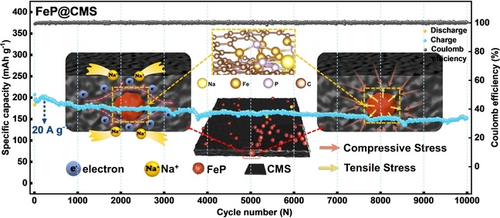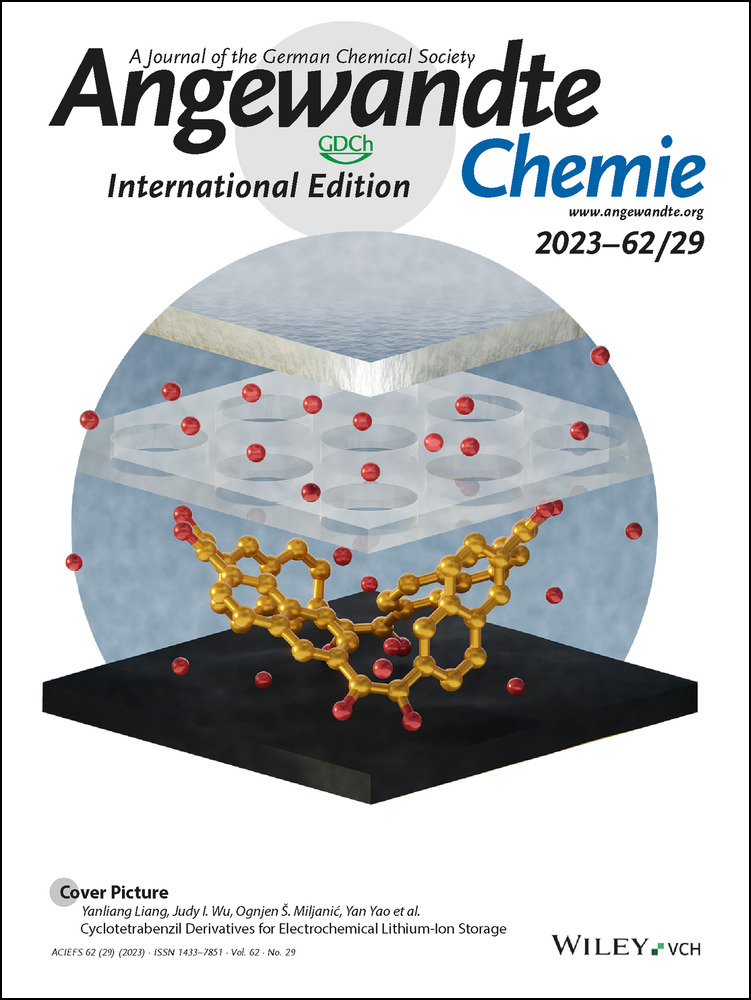A Stress Self-Adaptive Structure to Suppress the Chemo-mechanical Degradation for High Rate and Ultralong Cycle Life Sodium Ion Batteries
Yiming Liu
College of Science & Institute for Sustainable Energy, Shanghai University, Shanghai, 200444 China
These authors contributed equally to this work.
Contribution: Conceptualization (lead), Data curation (lead), Formal analysis (lead), Writing - original draft (lead)
Search for more papers by this authorProf. Jing Wang
Hebei Key Laboratory of Heavy Metal Deep-Remediation in Water and Resource Reuse, Yanshan University, Qinhuangdao, 066004 China
These authors contributed equally to this work.
Contribution: Data curation (equal), Formal analysis (equal), Writing - original draft (equal)
Search for more papers by this authorQinhao Shi
College of Science & Institute for Sustainable Energy, Shanghai University, Shanghai, 200444 China
Contribution: Data curation (supporting), Formal analysis (supporting), Investigation (supporting)
Search for more papers by this authorMouhui Yan
College of Science & Institute for Sustainable Energy, Shanghai University, Shanghai, 200444 China
Contribution: Data curation (supporting), Formal analysis (supporting)
Search for more papers by this authorShengyu Zhao
College of Science & Institute for Sustainable Energy, Shanghai University, Shanghai, 200444 China
Contribution: Data curation (supporting), Investigation (supporting)
Search for more papers by this authorDr. Wuliang Feng
College of Science & Institute for Sustainable Energy, Shanghai University, Shanghai, 200444 China
Contribution: Data curation (supporting), Formal analysis (supporting)
Search for more papers by this authorDr. Ruijuan Qi
Key Laboratory of Polar Materials and Devices (MOE) & Department of Electronics, East China Normal University, Shanghai, 200062 China
Contribution: Data curation (supporting), Resources (supporting)
Search for more papers by this authorProf. Jiaqiang Xu
College of Science & Institute for Sustainable Energy, Shanghai University, Shanghai, 200444 China
Contribution: Writing - review & editing (supporting)
Search for more papers by this authorProf. Jiayan Luo
State Key Laboratory of Metal Matrix Composites, School of Materials Science and Engineering, Shanghai Jiao Tong University, Shanghai, 200240 China
Contribution: Writing - review & editing (supporting)
Search for more papers by this authorProf. Jiujun Zhang
College of Science & Institute for Sustainable Energy, Shanghai University, Shanghai, 200444 China
Contribution: Writing - review & editing (supporting)
Search for more papers by this authorCorresponding Author
Prof. Yufeng Zhao
College of Science & Institute for Sustainable Energy, Shanghai University, Shanghai, 200444 China
Contribution: Conceptualization (lead), Formal analysis (lead), Funding acquisition (lead), Writing - review & editing (lead)
Search for more papers by this authorYiming Liu
College of Science & Institute for Sustainable Energy, Shanghai University, Shanghai, 200444 China
These authors contributed equally to this work.
Contribution: Conceptualization (lead), Data curation (lead), Formal analysis (lead), Writing - original draft (lead)
Search for more papers by this authorProf. Jing Wang
Hebei Key Laboratory of Heavy Metal Deep-Remediation in Water and Resource Reuse, Yanshan University, Qinhuangdao, 066004 China
These authors contributed equally to this work.
Contribution: Data curation (equal), Formal analysis (equal), Writing - original draft (equal)
Search for more papers by this authorQinhao Shi
College of Science & Institute for Sustainable Energy, Shanghai University, Shanghai, 200444 China
Contribution: Data curation (supporting), Formal analysis (supporting), Investigation (supporting)
Search for more papers by this authorMouhui Yan
College of Science & Institute for Sustainable Energy, Shanghai University, Shanghai, 200444 China
Contribution: Data curation (supporting), Formal analysis (supporting)
Search for more papers by this authorShengyu Zhao
College of Science & Institute for Sustainable Energy, Shanghai University, Shanghai, 200444 China
Contribution: Data curation (supporting), Investigation (supporting)
Search for more papers by this authorDr. Wuliang Feng
College of Science & Institute for Sustainable Energy, Shanghai University, Shanghai, 200444 China
Contribution: Data curation (supporting), Formal analysis (supporting)
Search for more papers by this authorDr. Ruijuan Qi
Key Laboratory of Polar Materials and Devices (MOE) & Department of Electronics, East China Normal University, Shanghai, 200062 China
Contribution: Data curation (supporting), Resources (supporting)
Search for more papers by this authorProf. Jiaqiang Xu
College of Science & Institute for Sustainable Energy, Shanghai University, Shanghai, 200444 China
Contribution: Writing - review & editing (supporting)
Search for more papers by this authorProf. Jiayan Luo
State Key Laboratory of Metal Matrix Composites, School of Materials Science and Engineering, Shanghai Jiao Tong University, Shanghai, 200240 China
Contribution: Writing - review & editing (supporting)
Search for more papers by this authorProf. Jiujun Zhang
College of Science & Institute for Sustainable Energy, Shanghai University, Shanghai, 200444 China
Contribution: Writing - review & editing (supporting)
Search for more papers by this authorCorresponding Author
Prof. Yufeng Zhao
College of Science & Institute for Sustainable Energy, Shanghai University, Shanghai, 200444 China
Contribution: Conceptualization (lead), Formal analysis (lead), Funding acquisition (lead), Writing - review & editing (lead)
Search for more papers by this authorGraphical Abstract
In this work, we report a novel architecture with FeP nanodots fully embedded in nitrogen doped carbon microplates skeleton (FeP@CMS) via the spatial confinement of carbon quantum dots (CQDs) . Such a structure allows the stress transfer between FeP nanodots and self-adaptive carbon matrix in sodium storage, which overcomes the intrinsic chemo-mechanical degradation of metal phosphides during long-term cycling.
Abstract
Transition-metal phosphides (TMPs) as typical conversion-type anode materials demonstrate extraordinary theoretical charge storage capacity for sodium ion batteries, but the unavoidable volume expansion and irreversible capacity loss upon cycling represent their long-standing limitations. Herein we report a stress self-adaptive structure with ultrafine FeP nanodots embedded in dense carbon microplates skeleton (FeP@CMS) via the spatial confinement of carbon quantum dots (CQDs). Such an architecture delivers a record high specific capacity (778 mAh g−1 at 0.05 A g−1) and ultra-long cycle stability (87.6 % capacity retention after 10 000 cycles at 20 A g−1), which outperform the state-of-the-art literature. We decode the fundamental reasons for this unprecedented performance, that such an architecture allows the spontaneous stress transfer from FeP nanodots to the surrounding carbon matrix, thus overcomes the intrinsic chemo-mechanical degradation of metal phosphides.
Conflict of interest
The authors declare no conflict of interest.
Open Research
Data Availability Statement
The data that support the findings of this study are available from the corresponding author upon reasonable request.
Supporting Information
As a service to our authors and readers, this journal provides supporting information supplied by the authors. Such materials are peer reviewed and may be re-organized for online delivery, but are not copy-edited or typeset. Technical support issues arising from supporting information (other than missing files) should be addressed to the authors.
| Filename | Description |
|---|---|
| anie202303875-sup-0001-misc_information.pdf3.6 MB | Supporting Information |
Please note: The publisher is not responsible for the content or functionality of any supporting information supplied by the authors. Any queries (other than missing content) should be directed to the corresponding author for the article.
References
- 1
- 1aR. Usiskin, Y. Lu, J. Popovic, M. Law, P. Balaya, Y.-S. Hu, J. Maier, Nat. Rev. Mater. 2021, 6, 1020–1035;
- 1bX. Yin, Z. Lu, J. Wang, X. Feng, S. Roy, X. Liu, Y. Yang, Y. Zhao, J. Zhang, Adv. Mater. 2022, 34, 2109282;
- 1cQ. Shi, R. Qi, X. Feng, J. Wang, Y. Li, Z. Yao, X. Wang, Q. Li, X. Lu, J. Zhang, Y. Zhao, Nat. Commun. 2022, 13, 3205;
- 1dS. Ye, L. Wang, F. Liu, P. Shi, Y. Yu, eScience 2021, 1, 75–82;
- 1eD. Gong, C. Wei, Z. Liang, Y. Tang, Small Sci. 2021, 1, 2100014.
- 2
- 2aG. Chang, Y. Zhao, L. Dong, D. P. Wilkinson, L. Zhang, Q. Shao, W. Yan, X. Sun, J. Zhang, J. Mater. Chem. A 2020, 8, 4996–5048;
- 2bQ. Liu, Z. Hu, Y. Liang, L. Li, C. Zou, H. Jin, S. Wang, H. Lu, Q. Gu, S. Chou, Y. Liu, S. Dou, Angew. Chem. Int. Ed. 2020, 59, 5159–5164;
- 2cZ. Hu, Q. Liu, W. Lai, Q. Gu, L. Li, M. Chen, W. Wang, S. Chou, Y. Liu, S. Dou, Adv. Energy Mater. 2020, 10, 1903542.
- 3
- 3aY. Wang, Y. V. Lim, S. Huang, M. Ding, D. Kong, Y. Pei, T. Xu, Y. Shi, X. Li, H. Y. Yang, Nanoscale 2020, 12, 4341–4351;
- 3bH. Jin, Y. Huang, C. Wang, H. Ji, Small Sci. 2022, 2, 2200015.
- 4Z. Li, L. Zhang, X. Ge, C. Li, S. Dong, C. Wang, L. Yin, Nano Energy 2017, 32, 494–502.
- 5G. Yuan, D. Liu, X. Feng, M. Shao, Z. Hao, T. Sun, H. Yu, H. Ge, X. Zuo, Y. Zhang, Adv. Mater. 2022, 34, 2108985.
- 6J. Tang, X. Peng, T. Lin, X. Huang, B. Luo, L. Wang, eScience 2021, 1, 203–211.
- 7
- 7aL. Shen, S. Shi, S. Roy, X. Yin, W. Liu, Y. Zhao, Adv. Funct. Mater. 2021, 31, 2006066;
- 7bY. Wang, Q. Fu, C. Li, H. Li, H. Tang, ACS Sustainable Chem. Eng. 2018, 6, 15083–15091;
- 7cJ. Li, Q. Liu, Y. Zhang, J. Jiang, H. B. Wu, X.-Y. Yu, Chem. Eng. J. 2021, 421, 127776.
- 8Q. Yang, W. Li, S. Chou, J. Wang, H. Liu, RSC Adv. 2015, 5, 80536–80541.
- 9S. Boyanov, J. Bernardi, F. Gillot, L. Dupont, M. Womes, J. M. Tarascon, L. Monconduit, M. L. Doublet, Chem. Mater. 2006, 18, 3531–3538.
- 10S. Shi, C. Sun, X. Yin, L. Shen, Q. Shi, K. Zhao, Y. Zhao, J. Zhang, Adv. Funct. Mater. 2020, 30, 1909283.
- 11C. Wang, J. Yan, T. Li, Z. Lv, X. Hou, Y. Tang, H. Zhang, Q. Zheng, X. Li, Angew. Chem. Int. Ed. 2021, 60, 25013–25019.
- 12H. Song, M. Wu, Z. Tang, J. S. Tse, B. Yang, S. Lu, Angew. Chem. Int. Ed. 2021, 60, 7234–7244.
- 13C. Xia, Y. Qiu, Y. Xia, P. Zhu, G. King, X. Zhang, Z. Wu, J. Y. Kim, D. A. Cullen, D. Zheng, P. Li, M. Shakouri, E. Heredia, P. Cui, H. N. Alshareef, Y. Hu, H. Wang, Nat. Chem. 2021, 13, 887–894.
- 14Y. Wang, N. Wu, Y. Qi, Z. Zhu, T. Zhang, X. Han, S. Li, J. Wu, J. Qiu, Appl. Surf. Sci. 2022, 585, 152569.
- 15T. Li, Q. Feng, T. Wang, Y. Sui, H. Chen, L. Ding, E. B. Chubenko, V. Bondarenko, X. Feng, W. Zhang, P. Cao, Appl. Surf. Sci. 2022, 599, 153915.
- 16J. Li, X. Li, P. Liu, X. Zhu, R. N. Ali, H. Naz, Y. Yu, B. Xiang, ACS Appl. Mater. Interfaces 2019, 11, 11442–11450.
- 17K. Zhang, M. Park, J. Zhang, G. Lee, J. Shin, Y. Kang, Nano Res. 2017, 10, 4337–4350.
- 18
- 18aY. Hu, RSC Adv. 2021, 11, 29620–29631;
- 18bZ. Yang, T. Zhao, X. Huang, X. Chu, T. Tang, Y. Ju, Q. Wang, Y. Hou, S. Gao, Chem. Sci. 2017, 8, 473–481;
- 18cZ. Li, H. Zhao, Z. Du, L. Zhao, J. Wang, Z. Zhang, J. Power Sources 2020, 465, 228253;
- 18dB. Tao, W. Yang, M. Zhou, L. Qiu, S. Lu, X. Wang, Q. Zhao, Q. Xie, Y. Ruan, J. Colloid Interface Sci. 2022, 621, 139–148.
- 19X. Wang, K. Chen, G. Wang, X. Liu, H. Wang, ACS Nano 2017, 11, 11602–11616.
- 20H. Huang, L. Wei, T. Tian, T. Cao, F. Cheng, Z. Chen, Z. Yang, B. Ge, M. Tian, W. Zhang, M. Niederberger, Energy Storage Mater. 2022, 47, 579–590.
- 21A. Wang, W. Hong, L. Li, R. Guo, Y. Xiang, Y. Ye, G. Zou, H. Hou, X. Ji, Energy Storage Mater. 2022, 44, 145–155.
- 22Y. Zhao, X. Cheng, K. Nie, Y. Han, J. Li, Comput. Theor. Chem. 2021, 1203, 113329.
- 23
- 23aP. J. Lezzi, M. Tomozawa, R. W. Hepburn, J. Non-Cryst. Solids 2014, 390, 13–18;
- 23bQ. Dong, G. Fang, Y. Huang, L. Hu, J. Yao, Z. Shao, S. Ling, X. Chen, J. Mater. Chem. B 2020, 8, 168–176.
- 24
- 24aJ. Wang, F. Fan, Y. Liu, K. L. Jungjohann, S. W. Lee, S. X. Mao, X. Liu, T. Zhu, J. Electrochem. Soc. 2014, 161, F3019–F3024;
- 24bS. Chao, Y. Song, C. Wang, H. Sheu, H. Wu, N. Wu, J. Phys. Chem. C 2011, 115, 22040–22047;
- 24cT. Wang, K. Zhang, M. Park, V. W.-h. Lau, H. Wang, J. Zhang, J. Zhang, R. Zhao, Y. Yamauchi, Y.-M. Kang, ACS Nano 2020, 14, 4352–4365.





